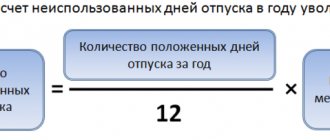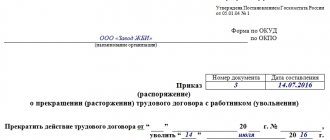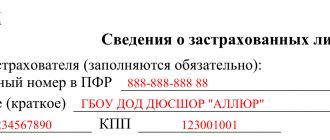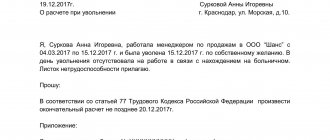Difficulties often arise with deductions upon dismissal. Here is just one example: an employee was accrued vacation pay, but the vacation was provided in advance; he did not work the days that needed to be worked, and is already resigning. What to do in this case?
You cannot oblige an employee to make up the missed days and not resign. And it is important for an accountant to know how to properly withhold funds in this case and in what amount, what can and cannot be withheld, and what to do with taxes and personal income tax.
Principles of calculating vacation pay
Each employee is now entitled to at least 28 days of rest per year (Article 115 of the Labor Code of the Russian Federation). Certain categories of workers are entitled to additional vacation days (for example, for irregular work hours, work in difficult, complex, dangerous conditions, etc.). They may be used at the discretion of the staff at any convenient time.
Annual paid leave is paid at the expense of the employer. To determine the amount of vacation pay due, you can use a simple formula:
Calculation formula
Amount otp = Sdvz (average daily earnings) * Kdo (number of rest days).
The same formula is used by accountants if an employee takes a vacation in advance and quits. It is used to determine the vacation pay due to him for the actual time worked, and deduct this amount from previously paid vacation pay. The resulting difference constitutes the employee's debt to the company.
The main difficulty for an accountant when calculating vacation pay is the correct determination of average daily earnings. It depends on:
- billing period;
- accrual amounts;
- number of days worked in the selected period.
The rules for calculating average earnings are given in Resolution No. 922 of December 24, 2007 (as amended). We list the main postulates that an accountant should know:
- If an employee has been working for a company for more than a year, his income for the 12 months preceding the vacation is taken into account. Otherwise, it is necessary to use for calculations earnings for the months worked preceding the month in which the employee goes on vacation. It is prohibited to arbitrarily change the billing period.
- The calculation includes only payments related to the payroll, i.e. accruals for actually worked hours, all kinds of bonuses, payments for achieving high results, overtime work, etc. Business trips, social benefits, vacation pay, one-time bonuses for anniversaries and other payments not related to payroll are excluded from the total income, since they themselves are determined by calculation.
- If staff salaries were raised during the billing period, earnings for previous months are indexed by the calculated coefficient.
The same rules apply if it is necessary to determine the amount of compensation for unused vacation upon dismissal or to recalculate vacation pay. The above formula is also used here.
When do unearned vacation pay appear?
The following example will help you understand the mechanism by which unearned vacation pay appears.
Technical University graduate P. N. Ptichkin got a job at a helicopter plant on July 1, 2019, and in January 2021 he received the right to go on vacation (paragraph 2 of Article 122 of the Labor Code of the Russian Federation) and took advantage of this opportunity. The duration of his vacation was 28 calendar days (Article 115 of the Labor Code of the Russian Federation).
Find out more about the provision of leave and its duration from the article “Annual paid leave under the Labor Code (nuances).”
During his vacation, he received a more lucrative job offer and immediately after returning from vacation, he quit the plant.
Thus, by the time of his dismissal, P.N. Ptichkin had earned only half of his legal leave: 14 days (6 months × 28 days / 12 months), and used all 28 days. There were 14 vacation days unworked at the time of dismissal (28 – 14).
Since the employee received the full amount of vacation pay before going on vacation, by the time of dismissal he had a debt to the company for the 14 days of vacation paid in advance.
IMPORTANT! The right to vacation for the first working year arises after six months of work in the organization (Article 122 of the Labor Code of the Russian Federation). Subsequent vacations are issued according to the approved schedule.
What the lack of a vacation schedule in a company can lead to, see the material “Unified Form No. T-7 - Vacation Schedule” .
When an employee takes rest in advance
There are quite a lot of situations in which an employee needs leave that he has not yet earned. Let's list the main ones:
- the vacation schedule is designed in such a way that some employees take them in advance;
- due to personal circumstances, the specialist is forced to go on vacation earlier than planned;
- the employee decides to quit without working for a full year;
- The company is experiencing staff reductions, and some of the staff are being laid off without being given the opportunity to take their required vacation.
In all these cases, the accountant needs to figure out how much vacation pay is due to dismissed employees, and, if necessary, make a deduction for unworked vacation days upon dismissal. Let's figure out how to do this without neglecting the norms of labor legislation.
Is it possible to do without deductions?
You can avoid deductions by signing a debt forgiveness agreement. Forgiving an employee’s debt means not raising the issue of the existence of a debt and not demanding its repayment.
In everyday life, settling a debt between individuals through forgiveness does not entail any consequences for both parties to the transaction. In a situation where one of the parties is a legal entity, debt forgiveness entails additional paperwork and also requires adjustment of tax obligations.
At the beginning of the procedure for forgiveness of vacation debt, you will need to draw up a document that reflects the will of the parties to repay the debt. Such a document may be an agreement on debt forgiveness for vacation overpayment.
The preparation of such a document is similar to similar agreements drawn up in the normal course of business. After the title of the document, the date and place of its preparation are indicated, followed by the parties to the agreement and its main text. It may contain the following content:
“...The employer exempts the employee from repaying the debt for 14 unworked vacation days in the amount of 10,025 (ten thousand twenty-five) rubles, which arose in connection with his dismissal under clause 3, part 1, art. 77 of the Labor Code of the Russian Federation until the end of the working year, towards which he used annual paid leave...”
The final elements of the agreement are the details and signatures of the parties.
Read about the next steps of debt forgiveness for unearned vacation pay in the next section.
Overpaid vacation pay: to keep or not
There is no provision in the law forcing the employer to recover from the employee the amount of overpaid vacation pay. Collecting a debt is the right, not the obligation of the employer.
When resolving this issue, it is recommended to proceed from whose initiative the employment contract is terminated. If the employee breaks the contract, he is obliged to repay the debt. If the employer terminates the employment relationship, he usually forgives the debt.
Free legal consultation
Free legal consultation We will answer your question in 5 minutes!
Ask a Question
We will answer your question in 5 minutes!
Ask a Question
This is also important to know:
Features of the dismissal procedure in case of bankruptcy of an enterprise
If the company decides to forgive an employee's debt, this should be documented. When dismissing an employee, it is recommended to conclude a bilateral agreement with him, which indicates the amount of vacation pay owed and the number of days of rest taken in advance.
A clause stating the absence of financial claims is often included in the document in order to exclude the very possibility of their occurrence. The rest of the agreement is drawn up according to the rules of business transactions.
In practice, most companies force staff to reimburse overpaid vacation pay, since no one wants to bear additional expenses. Consequently, if an employee took a vacation in advance and quits, the accountant will have to calculate the amount of “extra” vacation pay. An analysis of the following situation will help you understand the mechanism for calculating debt.
Example 2
Nikodimov A.D. got a job as a foreman on 02/01/2019. By agreement with management, he took the first part of his vacation from June 1 to June 14, 2021, and the second from September 1 to September 14, 2021. While still on vacation, Nikodimov decided to quit. Based on the statement, his last day of work in the organization was September 15, 2019.
In fact, the employee worked for the company for only 7 months. During this period, he is entitled to 16.31 days of rest (2.33 * 7). However, the employee used his entire vacation. Since the company did not want to forgive his vacation pay debt, the accountant needs to withhold vacation pay upon dismissal, used by Nikodimov A.D. in advance.
11.69 vacation days (28 – 16.31) are subject to compensation. Let's assume that the average daily earnings, calculated in accordance with Resolution No. 922, amounted to 965.80 rubles. Therefore, 11,290.20 rubles must be withheld from the employee. (11.69 * 965.80). As can be seen from the example, the employee’s debt to the company turned out to be quite significant.
Example
Initial data:
Sidorov got a job on April 1, 2021.
From July 10, 2021, he asked for 28 days of leave in advance.
The employer granted Sidorov’s request and paid him vacation pay, with the average daily earnings at the time of payment being 1,100 rubles.
Having returned to work from vacation, Sidorov decided to quit and submitted his resignation on August 30, 2021.
The settlement amount upon dismissal (salary for hours worked in August) was 12,000.
Will the employer be able to withhold overpaid vacation pay from Sidorov?
Calculation:
- The application submission date is 08/30/2019, which means the dismissal date is September 13, 2021.
- Vacation period – from 04/01/2019 to 09/13/2019 – is 5 full months.
- Vacation experience entitles you to 5*2.33 days. = 11.65 vacation days.
- Sidorov took 28 days off, which means he was given 28 – 11.65 = 16.35 days in advance.
- Vacation pay in advance = 16.35 * 1100 = 17,985 - this amount is refundable.
- The employer can withhold from Sidorov = 12,000 * 20% = 2,400.
- Unretained balance = 17,985 – 2,400 = 15,585.
The employer may offer Sidorov to return 15,585 rubles. voluntarily to the cash register or to a current account.
Sidorov is not obliged to agree and can refuse the return, receive his payment and leave the organization.
The employer can either forget about the debt or go to court with a lawsuit. However, the outcome of the trial is ambiguous.
How are vacation pay retained?
Usually, upon final payment, the employee is owed money for several days worked but not yet paid. From this amount, in fact, deductions are made for unused vacation upon dismissal. The employee is simply paid the difference between the last month’s salary and previously accrued vacation pay. The accountant does not need additional instructions for such an operation, just as there is no need to obtain the employee’s consent to adjust the payments due.
Sometimes wages are not enough to pay off the debt (in the example above, the employee was owed only 1 day's wages) or there is none at all. Then the resigning employee must repay the debt on his own. This is usually done by depositing cash into the company's cash desk.
The accountant who recalculated vacation pay issues a credit order to the employee upon his dismissal. Based on this document, the employee deposits the excess amount paid to him into the cash register. If the debt is repaid in full, the quitter receives his work book and says goodbye to the employer.
Sometimes an employee refuses to reimburse overruns, citing lack of funds. The employer can meet him halfway by increasing the debt payment period to 1 month. If after this time the debt remains unpaid, the employer has the right to go to court to recover funds.
Hassle-free option
Let's simulate the situation. Let’s say an employee was granted leave for an unworked period of time, that is, in advance. He was accrued vacation pay in the amount of 60,000 rubles. After some time in the same tax (calculation) period, he resigns. The amount of accruals to an employee upon dismissal is 70,000 rubles. Payment for unworked vacation days - 10,000 rubles. To simplify the example, we will assume that the employee did not have any other income and no personal income tax deductions are provided to him.
First, we will determine whether it is possible to withhold the entire amount for unworked vacation days from the payments due to the employee upon dismissal.
The amount due to the employee upon dismissal minus personal income tax is 60,900 rubles. (RUB 70,000 – RUB 70,000 x 13%). The maximum possible amount of deduction from this amount is RUB 12,180. (RUB 60,900 x 20%). In our case, you need to withhold 8,700 rubles. (RUB 10,000 – RUB 10,000 x 13%). Thus, the amount of payments to the employee is enough to withhold the entire amount. As a result, the employee will receive 52,200 rubles.
Personal income tax
The calculation of personal income tax amounts from income received by an employee is carried out by the company on an accrual basis from the beginning of the calendar year, with the offset of the amount of tax withheld in previous months (clause 3 of Article 226 of the Tax Code of the Russian Federation). When paying vacation pay (including for unworked vacation days), the employee received income in the amount of 60,000 rubles, and the company, on the basis of clause 4 of Art. 226 of the Tax Code of the Russian Federation lawfully withheld personal income tax from him in the amount of 7,800 rubles. (RUB 60,000 x 13%).
Upon dismissal, part of this income attributable to unworked vacation days is withheld from the payment due to him (that is, in fact, a portion of the vacation pay is returned). In letter dated October 30, 2015 No. 03-04-07/62635, the Russian Ministry of Finance explained that if an employee returns previously paid vacation pay to the employer, such amounts will not be recognized as the employee’s income. Accordingly, it is necessary to adjust the tax base for personal income tax for the tax period for this employee. In this case, the tax agent will overpay personal income tax. These clarifications from the financiers were brought to the attention of lower tax authorities by letter of the Federal Tax Service of Russia dated November 11, 2015 No. BS-4-11/ [email protected]
Please note: the tax agent does not have the right to offset the above overpayment against future personal income tax payments, but can only return it (letter of the Federal Tax Service of Russia dated 02/06/2017 No. GD-4-8/ [email protected] ). The fact is that payment of personal income tax at the expense of tax agents is not allowed (clause 9 of article 226 of the Tax Code of the Russian Federation). Consequently, transferring to the budget an amount exceeding the amount of tax actually withheld from the income of individuals does not constitute payment of personal income tax. In this case, the tax agent has the right to contact the tax authority with an application for the return to the current account of an amount that is not personal income tax and was mistakenly transferred to the budget.
Upon dismissal, the employee is accrued income in the amount of 70,000 rubles, personal income tax on which is 9,100 rubles. (RUB 70,000 x 13%). The company must transfer this tax to the budget no later than the day following the day of payment (clause 6 of Article 226 of the Tax Code of the Russian Federation).
Due to the recalculation of vacation pay, the amount of income received by the employee during the period of their payment decreased. Provisions of paragraph 6 of Art. 81 of the Tax Code of the Russian Federation obliges the tax agent to submit an updated calculation of 6-NDFL if distortions are identified in the previously submitted calculation, as well as errors leading to an underestimation or overestimation of the tax amount. In our case, the amount of tax to be transferred to the budget for the period of accrual of vacation pay turned out to be overestimated. Consequently, the company must submit an updated 6-NDFL calculation for this period.
Insurance premiums
The basis for insurance premiums is formed by payments and rewards accrued in favor of an individual from the beginning of the calendar year (clause 1 of Article 421 of the Tax Code of the Russian Federation). In our example, during the vacation pay accrual period, this base was 60,000 rubles. When an employee was dismissed due to deduction for unworked vacation days, the amount of previously accrued vacation pay was reduced and amounted to 50,000 rubles. (60,000 rub. – 10,000 rub.). In addition, he was awarded payments in the amount of 70,000 rubles. Thus, during the dismissal period, the base for calculating insurance premiums is 120,000 rubles. (50,000 rub. + 70,000 rub.). Based on this value, in the month of dismissal the company calculates the insurance premiums payable, minus the amounts of insurance premiums for the previous months of the year (clause 1 of Article 431 of the Tax Code of the Russian Federation).
Please note that in the situation under consideration, there is no need to adjust the base during the vacation pay accrual period. After all, when calculating them, the company acted in accordance with the requirements of the law and did not make any errors or distortions. Accordingly, she should not submit an updated calculation of insurance premiums for this period. This is confirmed by the explanations given in the letter of the Ministry of Health and Social Development of Russia dated May 28, 2010 No. 1376-19. And although they were given at a time when the procedure for calculating insurance premiums was regulated by the provisions of Federal Law No. 212-FZ dated July 24, 2009, in our opinion, they are still applicable now. The fact is that the procedure for calculating insurance premiums, provided for by Chapter 34 of the Tax Code of the Russian Federation, is similar to that established by the above law.
Let us note that there are letters from the Federal Tax Service of Russia dated October 11, 2017 No. GD-4-11/20479, dated August 24, 2017 No. BS-4-11/ [email protected] in which tax authorities talk about the need to submit an updated calculation of insurance premiums when withholding for unworked vacation days. But they are talking about a situation where, due to retention, negative values appear in the calculation. We will talk about when this happens below.
Income tax
Vacation pay is taken into account as part of labor costs (clause 7 of Article 255 of the Tax Code of the Russian Federation, letter of the Ministry of Finance of Russia dated July 22, 2016 No. 03-03-06/1/43097). Since they were accrued in accordance with the requirements of the law, their entire amount (including that paid in advance for unworked vacation days) was legally included in the expenses of the reporting period in which the employee was on vacation. This means that the company did not make any errors or distortions of the tax base during this period. Therefore, adjustments in connection with the subsequent withholding of overpaid vacation pay are not necessary.
A retention transaction refers to the period during which an employee is dismissed. Its result is the receipt of employee funds into the ownership of the company. That is, she receives income. Since it is not related to sales, it must be taken into account as part of non-operating income on the basis of Art. 250 Tax Code of the Russian Federation.
Financiers and tax specialists also think (letters from the Ministry of Finance of Russia dated December 3, 2009 No. 03-03-05/224, Federal Tax Service of Russia for Moscow dated January 11, 2007 No. 21-08 / [email protected] ). At the same time, they indicate that income must include the amount that was previously included in expenses. Thus, on the date of withholding, the company takes into account excess accrued vacation pay in the amount of RUB 10,000. as part of non-operating income.
Accounting entries
It is important to properly reflect the withholding of vacation pay upon dismissal on the balance sheet. To do this, an entry is made in the accounts of salaries and expenses for them. The previously made entry to reflect vacation pay is reversed, and instead, a posting is generated for the amount of compensation upon dismissal. For example,
This is also important to know:
How compensation is made for unused vacation upon dismissal
Dt 20 – Kt 70 in the amount of RUB 15,000.00. (reversal of vacation pay previously reflected in the balance sheet).
Dt 20 – Kt 70 in the amount of 10,000.00 (correctly calculated amount of compensation).
A credit balance of 70 means that the withholding for vacation upon dismissal resulted in the employee's debt to the company. As stated above, this debt is usually refundable. Repayment can be reflected by posting:
Dt 50 – Kt 70 (the employee paid the company in cash).
It is possible to transfer the debt non-cash to the company's current account, but laid-off workers rarely take advantage of this option.
The debit balance on account 70 shows that the deduction upon dismissal for the leave provided in advance did not result in the employee’s debt. In other words, the payments due to him were enough to compensate for the overpayment of vacation pay. In this case, the remaining money is given to the dismissed person in cash or transferred to his plastic card:
Dt 70 – Kt 50 (51).
Prohibition on withholding vacation pay
Sometimes an accountant is tormented by the question of how to retain overpaid vacation pay upon dismissal, but it turns out that this is not necessary. Article 137 of the Labor Code of the Russian Federation lists situations in the event of which it is prohibited to deprive an employee of money previously paid to him. Here are the reasons for dismissal:
- voluntary or forced liquidation of the company;
- termination of contracts with senior management due to a change in ownership;
- conscription of an employee for compulsory military or alternative service;
- recognition of an employee as incapacitated (injury, disability, general deterioration in health);
- refusal to transfer to another job (position) for medical reasons;
- the employer’s inability to provide the employee with work that suits his or her state of health;
- reinstatement of a previously dismissed specialist in his position based on a decision of the labor inspectorate;
- the occurrence of any force majeure circumstances that make further operation of the enterprise impossible.
Here, withholding already paid vacation pay is illegal. These cases oblige the company's management to pay compensation for unused vacation in case of untimely dismissal, and not to withhold debts from the staff.
Knowledge of the rules listed above will help the accountant competently approach the issue of calculating vacation pay amounts and withhold overpayments from staff only in situations stipulated by law. It is necessary for every accountant to understand how overpayments are withheld for unused vacation by an employee upon early dismissal.
Methodology for calculating advance vacation pay
If a decision is made to withhold overpaid vacation pay from an employee, the accountant needs to follow the following algorithm:
- determine how many vacation days the employee is entitled to;
- find out how many days were not worked;
- recalculate the average salary of the dismissed person;
- determine the amount of vacation pay due;
- find the difference between the amount paid and the amount due;
- figure out what to do with the amount of overpaid vacation pay.
Other payments
As you know, an individual can rely not only on wages. This, for example, could be travel allowances, benefits and other types of income. So, payment for extra vacation days cannot be withheld from everything. For example, this is prohibited from the following payments :
- to compensate the employee for harm;
- in connection with a business trip, transfer or assignment to another location;
- as compensation for wear and tear of the employee’s own tools that he or she uses at work;
- in connection with the registration of marriage, the birth of a child or the death of a loved one.
Calculation of advance holiday pay
Let's calculate advance vacation pay according to the above methodology:
It is convenient to calculate the number of days of unworked vacation using the following formula:
Quantity Neg. days = Number of days Spanish otp. – (Number of daily departures / 12 months * Number of months of work).
This is also important to know:
Probationary period when hiring: its duration, sample employment contract
The amount of vacation pay for the unworked period will be determined using the following formula:
Free legal consultation We will answer your question in 5 minutes!
Call: 8 800 511-39-66
∑ O neot. days = Number of Neg. days * Wed days charge
Free legal consultation
We will answer your question in 5 minutes!
Ask a Question
If during the billing period there was an increase in salaries for all employees of the company, then the average daily earnings for the months preceding the month of the increase will have to be multiplied by an adjustment factor. You will also have to calculate how many vacation days occurred in the months before the salary increase and the months after the increase.
In this case, the formula for calculating the amount of vacation pay will take a more complex form:
∑ O neot. days = Number of days otp. up to higher salary * Wed day charge 1 + Number of days otp. after promotion salary * Avg. days charge
Example 3
Technologist E. D. Kurbatov decided to quit. Vacation for 2021 was fully used, the employee rested for 28 days according to the schedule. At the time of dismissal, the accountant received the following information:
- 14 days of vacation have been used in advance;
- average daily earnings for calculating vacation pay - 1150 rubles;
- On June 20, 2021, all company employees received salary increases;
- Kurbatov E.D.’s vacation ended on June 30, 2019;
- the employee's salary was 28,000.00 rubles. - before increase and 30,000.00 rub. - after promotion.
Let's calculate advance vacation pay using the above algorithm and find out whether the company overpaid the employee a lot:
- The number of vacation days falling during the period before the salary increase is 11 (from June 20 to June 30).
- The number of vacation days falling during the period after the salary increase is 3 (14 – 11).
- The amount of debt to the employer is 17,003.57 rubles. (3 days * 1150 rub. + 11 days * (1150 rub. * (30,000 rub. / 28,000 rub.)).
Karabutov E.D. received this amount in advance before going on vacation, but did not work it out.
There is a resignation letter: actions of an accountant
The first thing an accountant should do when terminating an employee is to check all of his vacation days to determine whether he has any unworked days.
To do this you need to calculate:
— how many years and months the employee worked in the company. In this case, the last month is considered as full if it is worked half or more. If less than half of it is worked, the month is not taken into account in the calculation (clause 35 of the Rules on regular and additional leaves, approved by the People's Commissariat of Labor of the USSR on 04/30/30 No. 169);
— the number of vacation days due to the employee for the entire period of his work in the company (earned vacation); the number of vacation days that the employee took during the entire time he worked for the company. Next, you need to compare the number of vacation days used with the number of days earned.
Example 2
The employee leaves on February 27, 2021. He was hired on October 10, 2021. During this time, he took two vacations of 28 days each.
1. At the time of dismissal, the employee had worked for the company for one year (from October 10, 2021 to October 9, 2021), four months (from October 10, 2021 to February 9, 2021) and 18 days (from 10 to 27 February 2018). Since the last month was worked more than half (18 days), it is considered full. Therefore, the employee's period of employment with the company is one year and five months.
2. For a year of work, vacation is 28 days, and for five months - 12 days (28 days: 12 months x 5 months). Thus, the employee earned 40 days of vacation (28 days + 12 days) for the entire period of work.
3. The number of vacation days taken is 56 days.
4. The number of unworked vacation days is 16 (56 days - 40 days).
Deduction upon dismissal for vacation provided in advance
The amount of overpaid vacation pay must be withheld from the resigning employee, but his income is not always enough to repay the debt. If we take the data from the previous example, it becomes clear that the required amount can be withheld from E.D. Kurbatov if the company must pay him a salary in about 13 days.
In the event that the salary arrears turn out to be less, the employee must voluntarily repay the debt from his own funds, or the remaining debt will have to be withheld from him in installments.
Article 138 of the Labor Code of the Russian Federation limits the amount of deductions from an employee’s salary to 20% of income. In some cases, the amount of deductions can be increased to 50%.
Overpayment calculation algorithm
When withholding money for unearned vacation, you must proceed in the following sequence:
- Find a note-calculation form T-60, which contains data on the employee’s average daily earnings used to calculate the amount of vacation pay. It is necessary to use this data because the company will return what it has already paid, and not recalculate the vacation again.
- Calculate the number of vacation days taken in advance.
- Determine the amount of overpayment by multiplying the average daily earnings and the number of days taken off excessively.
- Withhold overpayment from the employee (if possible).
Registration and retention of debt
There are only three options for what to do with overpaid vacation pay:
- The employee voluntarily repays the debt (deposits money into the cash register or transfers it non-cash to the company’s account).
- The accountant collects 20% of the debt at a time, the rest - in court (Article 382-383 of the Labor Code of the Russian Federation).
- The company forgives the employee's debt.
This is also important to know:
Dismissal - entry in the work book, sample 2021
The second and third options require the execution of appropriate orders, with which the dismissed person must be familiarized with a signature.
How can an employer issue a refund?
The deduction and return of the amount for unworked vacation is made when settling with the employee on the day of his dismissal.
To determine how much a worker owes for the unworked period, it is necessary to calculate the number of months and days worked in the organization, and the number of days he did not work before the end of the working year.
You can calculate the number of calendar days for which vacation pay is paid in advance in the following way:
- Divide the number of vacation days by 12 months and multiply by the number of months worked at the company.
- Subtract the resulting number in the first case from the number of vacation days for the duration of the employment contract.
When calculating the number of months, the number can be rounded. If less than half of the last month was worked, then it is not taken into account; if half or more was worked, then it is counted as one month worked.
The resulting number of unworked days may also be rounded to a whole number. This must be done in favor of the employee.
To calculate the amount of debt for the unworked period, subject to withholding upon dismissal, it is necessary to multiply the calculated number of unworked days by the amount of average earnings during the vacation.
Do I need to make an order?
An order to withhold the overpaid amount of vacation pay upon dismissal must be issued to the employer in order to protect itself from disputes and litigation with a former employee. There is no generally accepted form of the order, therefore its preparation is considered arbitrary for each organization.
The manager must issue a deduction order within a month from the end date for the return of the unworked advance. It is important to indicate in the document information about the employee (name, surname, position), the number of unworked days, and the amount of debt for the unworked period. Also at the end there should be a note stating that the employee is familiar with the conditions, and his signature to agree with what is written in the document.
Tax nuances
Adjusting vacation pay accruals leads to a change in the tax base, and, as a consequence, the need to recalculate taxes. Since this situation is not an accounting error, all corrections are made in the current period.
Personal income tax
The employer acts as a tax agent in relation to any payments to staff. Therefore, even from the amount of vacation pay paid in advance, it is necessary to withhold and pay personal income tax. Since the tax was withheld at the time of calculating vacation pay and transferred until the last day of the month in which the employee went on vacation, by the time of dismissal the amount of personal income tax has usually already been transferred to the budget.
If the employee decides to repay the debt, the excess tax accrued is reversed. Then the company has an overpayment of personal income tax, which can be returned from the budget in the generally established manner.
Excessively withheld personal income tax is returned to the employee. In addition, the accountant must submit a clarifying declaration 6-NDFL for the period of accrual of vacation pay. If personal income tax is adjusted for the past year, you will have to submit a “clarification” of 3-NDFL.
In cases where the employee refuses to repay the debt and the debt is forgiven, no personal income tax adjustment is required.
Income tax
A decrease in labor costs (which includes vacation payments) entails an increase in the tax base for income tax. Possible options for an accountant:
- the employee repays the debt or the company claims the debt in court - the “extra” vacation pay is reversed;
- the company forgives the debt - the amount of overpayment is excluded from the tax base (clause 49 of article 270 of the Tax Code of the Russian Federation).
Insurance premiums
Reversing the amounts of advance vacation pay leads to a decrease in the base for insurance premiums in the period of accrual of vacation pay. This entails the need to submit adjustment reports in form RSV-1 and 4-FSS.
Types of vacations
The right to rest is enshrined in the Basic Law of the country (Constitution of the Russian Federation, Article 37, paragraph 5). Every worker, according to this article, has the opportunity to rest not only on weekends established in accordance with his work schedule and statutory holidays, but can also receive annual leave.
Constitution of the Russian Federation Article 37
There are several types of vacations:
Basic
The duration of which, in accordance with Article 115 of the Labor Code of the Russian Federation, is 28 cal. days for workers under normal working conditions. The main vacation may exceed the established duration. In this case, it is considered elongated. For example, the category of employees with this type of leave includes the entire teaching staff. According to Government Decree No. 466 of 04/07/2017, they are granted from 42 to 56 days of basic extended leave. Also, for persons with a certificate of disability, annual leave cannot be less than 30 cal. days (Federal Law No. 181 of November 24, 1995, Article 23).
Labor Code of the Russian Federation N 197-FZ Article 115
Additional
The duration of which cannot be less than 3 days. Usually this type of rest is provided (Article 116 of the Labor Code of the Russian Federation):
- employees who have irregular hours;
- workers involved in work under hazardous working conditions;
- citizens who work in the regions of the Far North.
Training
Provided to employees undergoing training in various educational institutions. Such vacation can be either paid or unpaid. Payment by the employer is made only in a situation where the employee receives his first higher education. Moreover, the university must have state accreditation. If this is already the 2nd education, then the employer must provide vacation, but only at his own expense.
Study leave is provided to employees undergoing training in various educational institutions
Vacation without pay
If the first two types of vacation (main and additional) are paid, then this type of vacation is provided without any financial payments. This is the so-called “vacation at your own expense.” An employee receives it when he needs this type of rest. To do this, you need to fill out an application, which must indicate the duration of the time off, as well as their start date. For example, upon the birth of a child or due to the death of a close relative, an employee has the right to receive up to 5 days of unpaid leave at the enterprise. Pensioners can take an additional 2 weeks off at their own expense.
Typically, all vacations are granted on an actual basis. An exception is the main leave, which can be issued in the form of an advance and requires subsequent work to be reimbursed. If the employee decides to resign earlier than this, he will have to return the excess vacation pay.
Types of vacations
If the employee does not return the money used in advance
The judicial practice of collecting overpaid vacation pay is very ambiguous. Cases when employers turn to former employees with relevant claims are quite rare. There are several reasons for this:
- usually the amounts of overpayments turn out to be too insignificant to waste time and effort on claiming them;
- the former employee does not always have income that can be recovered;
- a positive court decision is possible if it can be proven that the employee’s unlawful actions led to damage to the entrepreneur (Articles 248, 391 of the Labor Code of the Russian Federation).
At the same time, the argument that there are insufficient funds to recover overpayments of vacation pay usually satisfies tax inspectors and does not entail negative consequences for the company.










